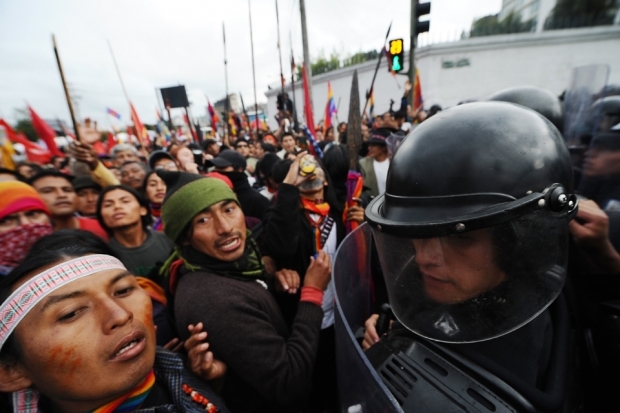After a three-year wait, China Railway Construction Corp. Ltd. (CRCC) recently won permission to launch a major copper mining project in Ecuador.
The production agreement signed April 25 by Ecuador’s government and Corriente Resources, a Canadian company jointly controlled by state-owned CRCC and the Chinese state mining giant Tongling Nonferrous Metals Group Holdings Co. Ltd., clears the way for digging to begin at the Mirador pit.
The deal first proposed in 2009 also marks the latest milestone in a quest by CRCC and other Chinese engineering firms to expand beyond domestic construction businesses by investing in mines around the world.
For example, CRCC’s main, state-owned competitor China Railway Group Ltd. (CRG), declared in a first-quarter 2012 financial report that it invested more than 200 million yuan in mineral resources last year and plans to open major mines this year.
“In the future, mining revenues will become a new growth point for the company,” the CRG report said.
In setting sights on the international mining industry, CRCC and CRG are betting that revenues from resource extraction in far-flung lands can make up for a slowdown affecting their domestic track-and-tie business.
Business has cooled since the Chinese government last year decided to cut back on railroad projects. Contributing to the decision was a corruption scandal in the national railways ministry and a deadly collision of two China Railways bullet trains that killed forty people.
CRCC signed only 137 billion yuan worth of new railway contracts in 2011, down 68 percent from 2010, while CRG said its new contract orders fell 76 percent to 97 billion yuan. CRCC’s operating revenues declined 2.7 percent between 2010 and last year, while CRG’s net profit for the same period fell 9.6 percent.
“Market expectations are for domestic railway construction investment to slow further over the next few years,” an infrastructure construction analyst told Caixin. “For railway contractors such as CRG and CRCC to further develop, they will have to transform and seek new growth points for their businesses.
“The construction industry is highly impacted by state investment that can’t guarantee a company’s future development path,” he said.
Shifting Gears
Market analysts say CRCC and CRG are following a trail blazed several years ago by another state-owned construction conglomerate, China Metallurgical Group Corp.
China Metallurgical shifted focus from its traditional field—domestic steel factory construction—to overseas mining. It now operates a lead and zinc mine in Pakistan, and has invested in nickel, copper and iron ore facilities in Papua New Guinea, Afghanistan, Australia, and Argentina.
Its best-known asset is the Aynak copper mine in Afghanistan, which has 690 million tons of proven reserves including 11 million tons of high-grade copper.
When China Metallurgical went public in 2009, investors were attracted to the company’s mining interests rather than its domestic engineering business, given the low profit forecasts at the time for the domestic steel industry.
CRCC executives apparently saw the writing on the wall for railroad building that same year: They started pushing into international mining in late 2009.
The State-owned Assets Supervision and Administration Commission granted a CRCC request to change the company’s primary business to mineral resources development. CRCC immediately tied up with Tongling to buy Corriente from its shareholders for C$ 679 million cash. The company soon delisted from the Toronto and New York stock exchanges.
Corriente focuses on copper, gold and silver extraction. Its main assets are the mineral rights and equity at the Mirador site, which has 660 million tons of proven mineral reserves including 3.5 million tons of copper ore.
The Mirador project plan calls for building a US$1.7 billion, open-pit mine that supplies up to 60,000 tons of ore daily by 2016.
Risk Factors
Buying a mine and winning government approval for a project such as Mirador are just two of many challenges facing CRCC and other Chinese companies in their quest to expand abroad.
People living in the Mirador area, for example, have reportedly staged protests over possible environmental damage, although the project was granted an environmental certificate from the Ecuador government.
Financial risks loom as well for China’s railway builders making the transition to international mining.
“CRCC and CRG are latecomers to the mineral extraction field,” said Zhang Lin, a mineral resources analyst at Lange Steel Information Center. “It is extremely difficult for them to find mineral sources with good-quality assets and low investment costs.
“There have been a lot of changes in the overseas mining industry environment since 2008. Local mining industry development is already very mature in traditional areas of concentrated mineral resources such as Australia and Canada, and those with high-quality mineral resources have already been divided up.
“Only some areas such as Africa, South America and Mongolia are left,” Zhang said. “Although there are more opportunities, risks are also higher.”
So far, mining has done little to lift CRG’s bottom line. The company reported 780 million yuan in revenues from its mineral resources segment in 2011—less than 0.2 percent of its total revenue that year.
Moreover, Zhang said, these companies face the kinds of investment risks that are typically high for parts of the world where mining is relatively new.
“These areas often have complex environments, such as low-grade minerals, a lack of infrastructure, political instability and changing government mining policies,” he said.
In the Democratic Republic of Congo, a lack of infrastructure poses a challenge for a cobalt and copper mine being built by CRG with China Metallurgical and Sinohydro Group Ltd., in cooperation with the Congo government.
The Cuvette Dima mining region is 2,700 kilometers from the mining area to the port, and in cutting a deal with the government the Chinese companies had to agree to build roads.
Gu Yongqiang is a Caixin staff reporter.




